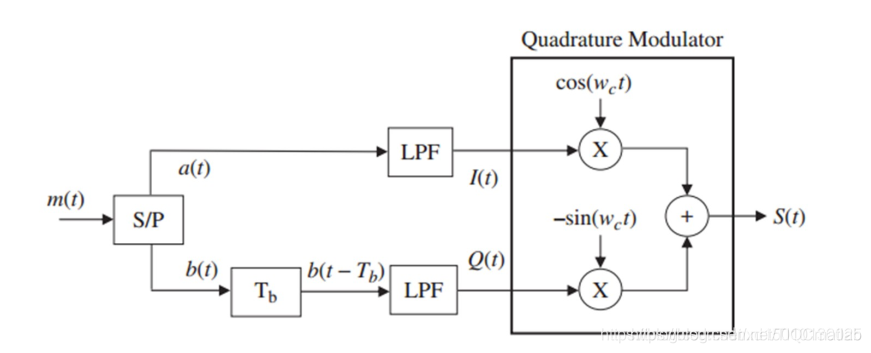【数字信号调制】基于matlab GUI QPSK调制+解调【含Matlab源码 646期】
【摘要】
一、获取代码方式
获取代码方式1: 完整代码已上传我的资源: 【数字信号调制】基于matlab GUI QPSK调制+解调【含Matlab源码 646期】
获取代码方式2: 通过订阅紫极神光博客付费专...
一、获取代码方式
获取代码方式1:
完整代码已上传我的资源: 【数字信号调制】基于matlab GUI QPSK调制+解调【含Matlab源码 646期】
获取代码方式2:
通过订阅紫极神光博客付费专栏,凭支付凭证,私信博主,可获得此代码。
备注:订阅紫极神光博客付费专栏,可免费获得1份代码(有效期为订阅日起,三天内有效);
二、QPSK简介
1 调制模型
与QPSK相比,OQPSk调制方式在复数通道Q通道中,插入了一个比特的时延Tb。

2.优点
OQPSK能够把180度的相移变化变成两个π /2的相位变化,因此相轨道远离了原点

3 解调
因为调制时Q路进行了延时,所以解调时I路进行延时

三、部分源代码
function varargout = GUI_QPSK(varargin)
% GUI_QPSK MATLAB code for GUI_QPSK.fig
% GUI_QPSK, by itself, creates a new GUI_QPSK or raises the existing
% singleton*.
%
% H = GUI_QPSK returns the handle to a new GUI_QPSK or the handle to
% the existing singleton*.
%
% GUI_QPSK('CALLBACK',hObject,eventData,handles,...) calls the local
% function named CALLBACK in GUI_QPSK.M with the given input arguments.
%
% GUI_QPSK('Property','Value',...) creates a new GUI_QPSK or raises the
% existing singleton*. Starting from the left, property value pairs are
% applied to the GUI before GUI_QPSK_OpeningFcn gets called. An
% unrecognized property name or invalid value makes property application
% stop. All inputs are passed to GUI_QPSK_OpeningFcn via varargin.
%
% *See GUI Options on GUIDE's Tools menu. Choose "GUI allows only one
% instance to run (singleton)".
%
% See also: GUIDE, GUIDATA, GUIHANDLES
% Edit the above text to modify the response to help GUI_QPSK
% Last Modified by GUIDE v2.5 03-Dec-2018 20:37:56
% Begin initialization code - DO NOT EDIT
gui_Singleton = 1;
gui_State = struct('gui_Name', mfilename, ...
'gui_Singleton', gui_Singleton, ...
'gui_OpeningFcn', @GUI_QPSK_OpeningFcn, ...
'gui_OutputFcn', @GUI_QPSK_OutputFcn, ...
'gui_LayoutFcn', [] , ...
'gui_Callback', []);
if nargin && ischar(varargin{1})
gui_State.gui_Callback = str2func(varargin{1});
end
if nargout
[varargout{1:nargout}] = gui_mainfcn(gui_State, varargin{:});
else
gui_mainfcn(gui_State, varargin{:});
end
% End initialization code - DO NOT EDIT
% --- Executes just before GUI_QPSK is made visible.
function GUI_QPSK_OpeningFcn(hObject, eventdata, handles, varargin)
% This function has no output args, see OutputFcn.
% hObject handle to figure
% eventdata reserved - to be defined in a future version of MATLAB
% handles structure with handles and user data (see GUIDATA)
% varargin command line arguments to GUI_QPSK (see VARARGIN)
% Choose default command line output for GUI_QPSK
handles.output = hObject;
s=round(rand(1,100)); %生成二进制基带数据并画出基带信号图
N=1:100;
%figure(1);subplot(311);stem(N,s);title('基带信号');grid on;
Ps=1;
M=4; %QPSK星座图
d=sqrt(Ps)*sin(pi/M);
A=[1+1*i,-1+1*i,-1-1*i,1-1*i]*d;
%subplot(312);scatter(real(A),imag(A),'filled');title('QPSK星座图');hold on;
theta=0:pi/100:2*pi;
x=cos(theta);
y=sin(theta);
%plot(x,y);grid on;
Maptable=[0 0;0 1;1 1;1 0]; %QPSK格雷码比特映射
for j=1:2:100
for m=1:M
if isequal(s(j:j+1),Maptable(m,:))
Qu((j+1)/2)= (2*m-1)*pi/4;
x((j+1)/2)=A(m);
break
end
end
end %基带数据s携带的信息映射到X[n]
Am=1; %载波调制
T=0.0001; fc=6/T;
Smpl=1000;
deltaT=T/Smpl; %连续时间离散化间隔
Ns=5; %画出Ns个符号的波形
t=deltaT:deltaT:Ns*T; %离散时间序列
for j=1:Ns
index=(j-1)*Smpl+1:j*Smpl; %第i个符号对应的离散时间序号
g(index)=1; %矩形脉冲成型
X(index)=Am*g(index).*cos(2*pi*fc*t(index)+Qu(ceil(index/100.01))); %载波调制信号
end
%subplot(313);plot(t,X);title('QPSK调制信号波形');
SNR_dB=15; %定义信噪比
SNR=10^(SNR_dB/10); %定义线性信噪比
Ps=1; %发射功率
Pn=Ps/SNR; %噪声方差
x=x(1:50);
z=sqrt(Pn/2)*(randn(size(x))+randn(size(x))*i); %生成白噪声
h=1; %AWGN信道下,信道增益h=1
y=h*x+z; %基带接受信号
%figure(2);subplot(211);scatter(real(y(1:10)),imag(y(1:10)),'filled'); %y的星座图title('QPSK接收星座图');
for j=1:length(y)
Dist=abs(y(j)-A); %第j个接受信号与各星座图点的距离
[~,Index]=min(Dist); %找到距离最近的点
x_est(j)=A(Index); %得到发射调制信号的估计
s_est(2*j-1:2*j)=Maptable(Index,:); %得到比特数据的估计
end
W=1:100;
%subplot(212);stem(W,s_est);title('QPSK解调后信号');
for n=1:25
Pe_t(n)=2*sqrt(2)/4*erfc(sqrt(2*n)*sin(pi/M))-sqrt(2)/4*erfc(sqrt(2*n)*sin(pi/M))* sqrt(2)/4*erfc(sqrt(2*n)*sin(pi/M));
Pb_t(n)=0.5*Pe_t(n);
end
PESUM=0;
PBSUM=0
for n=1:25
for m=1:1000
SNR=n;
Ps=1;
Pn=Ps/SNR;
z=sqrt(Pn/2)*(randn(size(x))+randn(size(x))*i);
h=1;
y=h*x+z;
for j=1:length(y)
Dist=abs(y(j)-A);
[~,Index]=min(Dist);
x_est(j)=A(Index);
s_est(2*j-1:2*j)=Maptable(Index,:);
end
for k=1:100
if(s(k)+s_est(k)==1)
PBSUM=PBSUM+1;
end
end
for k1=1:50
if isequal(x(k1),x_est(k1))
PESUM=PESUM+0;
else
PESUM=PESUM+1;
end
end
end
Pb(n)=PBSUM/1000/100;
Pe(n)=PESUM/1000/50;
PBSUM=0;
PESUM=0;
end
SNRX=1:25;
%figure(3);plot(SNRX,Pb); hold on;plot(SNRX,Pe);scatter(SNRX,Pe_t);scatter(SNRX,Pb_t, 'filled');
%xlabel('信噪比 SNR(r/dB)');title('AWGN信道下误码率与误符号率曲线'); axis([1 25 0 1]);grid on;hold off;
H=sqrt(1/2)*(randn+i*randn);
Y=H*x+z;
%figure(4);subplot(211);scatter(real(Y(1:10)),imag(Y(1:10)),'filled');title('4PSK信道均衡前星座图');
Y1=Y/H;
%subplot(212);scatter(real(Y1(1:10)),imag(Y1(1:10)),'filled');title('4PSK信道均衡后星座图');
PESUM1=0;
PBSUM1=0
for n=1:25
for m=1:1000
SNR=n;
Ps=1;
Pn=Ps/SNR;
z=sqrt(Pn/2)*(randn(size(x))+randn(size(x))*i);
Y1=(H*x+z)/H;
for j=1:length(Y1)
Dist=abs(Y1(j)-A);
[~,Index]=min(Dist);
x_est1(j)=A(Index);
s_est1(2*j-1:2*j)=Maptable(Index,:);
end
for k=1:100
if(s(k)+s_est1(k)==1)
PBSUM1=PBSUM1+1;
end
end
for k1=1:50
if isequal(x(k1),x_est1(k1))
PESUM1=PESUM1+0;
else
PESUM1=PESUM1+1;
end
- 1
- 2
- 3
- 4
- 5
- 6
- 7
- 8
- 9
- 10
- 11
- 12
- 13
- 14
- 15
- 16
- 17
- 18
- 19
- 20
- 21
- 22
- 23
- 24
- 25
- 26
- 27
- 28
- 29
- 30
- 31
- 32
- 33
- 34
- 35
- 36
- 37
- 38
- 39
- 40
- 41
- 42
- 43
- 44
- 45
- 46
- 47
- 48
- 49
- 50
- 51
- 52
- 53
- 54
- 55
- 56
- 57
- 58
- 59
- 60
- 61
- 62
- 63
- 64
- 65
- 66
- 67
- 68
- 69
- 70
- 71
- 72
- 73
- 74
- 75
- 76
- 77
- 78
- 79
- 80
- 81
- 82
- 83
- 84
- 85
- 86
- 87
- 88
- 89
- 90
- 91
- 92
- 93
- 94
- 95
- 96
- 97
- 98
- 99
- 100
- 101
- 102
- 103
- 104
- 105
- 106
- 107
- 108
- 109
- 110
- 111
- 112
- 113
- 114
- 115
- 116
- 117
- 118
- 119
- 120
- 121
- 122
- 123
- 124
- 125
- 126
- 127
- 128
- 129
- 130
- 131
- 132
- 133
- 134
- 135
- 136
- 137
- 138
- 139
- 140
- 141
- 142
- 143
- 144
- 145
- 146
- 147
- 148
- 149
- 150
- 151
- 152
- 153
- 154
- 155
- 156
- 157
- 158
- 159
- 160
- 161
- 162
- 163
- 164
- 165
- 166
- 167
- 168
- 169
- 170
- 171
- 172
- 173
- 174
- 175
- 176
- 177
- 178
- 179
- 180
- 181
- 182
- 183
- 184
- 185
- 186
- 187
- 188
- 189
- 190
- 191
- 192
- 193
- 194
- 195
- 196
- 197
四、运行结果





五、matlab版本及参考文献
1 matlab版本
2014a
2 参考文献
[1] 沈再阳.精通MATLAB信号处理[M].清华大学出版社,2015.
[2]高宝建,彭进业,王琳,潘建寿.信号与系统——使用MATLAB分析与实现[M].清华大学出版社,2020.
[3]王文光,魏少明,任欣.信号处理与系统分析的MATLAB实现[M].电子工业出版社,2018.
文章来源: qq912100926.blog.csdn.net,作者:海神之光,版权归原作者所有,如需转载,请联系作者。
原文链接:qq912100926.blog.csdn.net/article/details/115292958
【版权声明】本文为华为云社区用户转载文章,如果您发现本社区中有涉嫌抄袭的内容,欢迎发送邮件进行举报,并提供相关证据,一经查实,本社区将立刻删除涉嫌侵权内容,举报邮箱:
cloudbbs@huaweicloud.com
- 点赞
- 收藏
- 关注作者


评论(0)